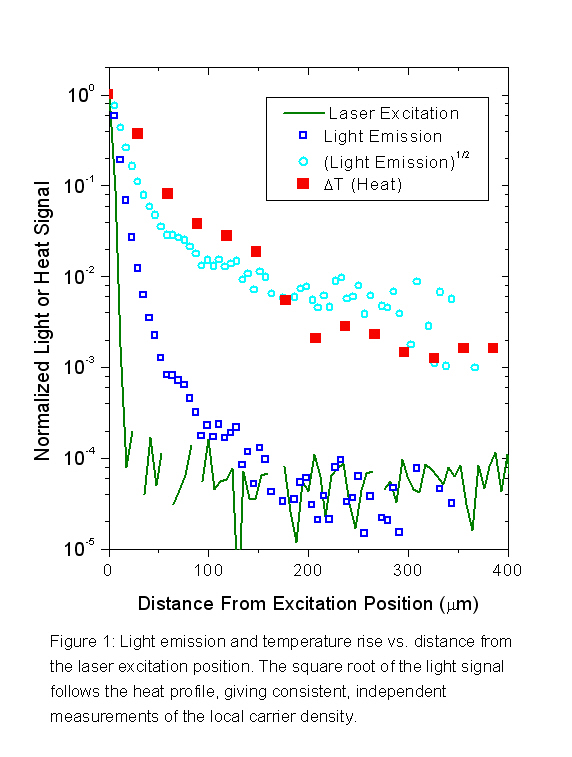AmericanChemicalSociety.com
Reports: B10 46713-B10: Exploring Defect Level Position and Occupation in Metamorphic Heterostructures for Multi-junction Photovoltaic Converters
Timothy H. Gfroerer, Davidson College
When electrons are excited from the valence band into the conduction band of a semiconductor, they can return to the ground state by emitting light or heat. Light- and heat-generating recombination decrease the efficiency of GaAs-based solar cells because the release of light or heat reduces the energy available for generating electricity. Heat-generating transitions usually occur through localized intermediate energy levels that are present near crystalline defects. Prior to this summer, we have always used optical emission (photoluminescence) as an indirect measure of the heat-generating counterpart defect-related recombination. This year we added another powerful technique to our semiconductor characterization facilities at Davidson College: high resolution thermal imaging. With our new FLIR T300 thermal camera and close-up germanium lens, we can now study the heat-generation directly.
For our first experiment with this camera, PRF-supported undergraduate student Ryan Crum investigated the outward diffusion of free electrons and holes from a highly localized excitation spot. We focus a 340 mW (only 170 mW is absorbed), 532 nm Gaussian laser beam to a spot size of ~ 4 microns FWHM on the surface of a GaAs/GaInP double heterostructure. In order to optimize the speed of the thermal imaging, a shutter is used to synchronize the laser excitation with individual frames from the FLIR T300 thermal camera (30 Hz).
High resolution images of luminescence (radiative recombination) have been used by others to monitor the diffusion of electrons and holes away from the excitation position. But these studies often assume that the luminescence signal is proportional to the local carrier density, which is only true for doped materials in the low injection regime. In undoped materials, or at high injection, the luminescence intensity is proportional to the product of the free electron and hole densities, which are approximately equal. Hence, the square root of the luminescence signal should yield a better measure of the local carrier density.
In our study, we measure the luminescence profile along with the temperature gradient due to heat generation. We obtain temperature profiles that are broader than the profiles of luminescence (see Fig. 1). This observation is consistent with how these mechanisms depend on carrier density: defect-related recombination should be approximately proportional to the density of carriers while radiative-recombination is proportional to the density of carriers squared (as noted above). Since the carrier density decreases with distance from the excitation position, radiative recombination dominates at short distances while heat-generating recombination becomes more important with increasing distance. And when we take the square root of the luminescence signal, we obtain a carrier density profile that matches the heating profile quite well. We expect to publish these novel and exciting results soon.
This summer, we also continued our investigation of excitation-dependent diffusion to isolated dislocations in GaAs. Undergraduate student Mark Crowley, funded by Davidson in a match to PRF support, used the Easy Java Simulations (EJS) programming environment to extend the previous PRF-supported work by Mac Read (2010 honors degree in physics, now in the graduate Nuclear Engineering Program at the University of South Carolina). In photoluminescence images of GaAs, Mac observed isolated dark regions (presumably crystal dislocations) where the darkened area increased substantially with decreasing laser excitation (see Fig. 2).
At lower excitation, fewer carriers are present and therefore it takes longer for them to pair up and recombine. This extended lifetime allows more time for a carrier to encounter a defect. At higher excitation, more carriers are present and individual carriers are more likely to find a partner for radiative recombination before reaching the defect. Carrier diffusion creates similar depleted (or dead) regions near dislocations in solar cells. At high excitation, the depletion region is small and many carriers can be extracted for electricity. At lower excitation the depletion region of the defect grows and carriers close to the dislocation will be lost to defect-related recombination.
When Mac modeled the behavior with a simulation that allows for Laplacian diffusion and defect-related recombination only through mid-bandgap energy levels, he did not obtain good agreement between the experimental and simulated images (see Fig. 3). However, Mac found that he could achieve improved agreement if he allowed the defect recombination parameter A, which depends on the density of states and the capture time, to vary with excitation. Such variation is not physical (these quantities don't change!), but it does point the way to a better solution. If we allow for an arbitrary distribution of defect levels between the valence and conduction bands, and keep track of the occupation of defect and band states, we have more flexibility for fitting the excitation-dependent recombination rates. Mark has employed this model successfully and obtained a better match with the experimental images (see Fig. 4).
If we had more accurate experimental images, we believe that we could obtain even better agreement than the results shown in Fig. 4. Hence, we have collected a new set of experimental images, including a measurement of the laser excitation profile, which we intend to incorporate into the fitting procedure. This effort is nearly complete and we intend to publish our findings from this project in the near future. Since I will be taking a sabbatical in the 2011-12 academic year, I will have an excellent opportunity to compile comprehensive results from this PRF grant and evaluate where my research program is headed next. One possibility is a new collaboration with scientists at the University of North Carolina at Charlotte, the University of California at Berkeley, North Carolina State University, and Rutgers University. We have just submitted a pre-proposal to the National Science Foundation for the formation of a new Materials Interdisciplinary Research Team (MIRT), with the goal of investigating emerging chalcogenide semiconductor photovoltaic materials. Full MIRT proposals, allowed by invitation only, will be due on January 13th, 2011 with an anticipated start date of August 1st, 2011.
Copyright © American Chemical Society



